December 17th, 2004
This entry is a bit different. I actually worked on the Elizabethan
Peascod-Style Doublet in the early part of this year. However, I
wasn't into dress diaries on my LJ at that time. However, I did
take some photos of my work in progress, and images of my husband
wearing the completed doublet, sans proper sleeves and wearing a
borrowed cap. The sleeves are mostly done, awaiting time when I
can hand sew his eyelets for lacing. He now wears the Italian
bonnet I made, and a blackwork shirt, which needs a dress diary
entry.
The style is similar to the Elizabethan "peascod" doublets
common during the 1580s. The peascod is normally stuffed into an
exagerated oversized stomach, to mimic the paunch of a well-fed
man. Yes, that was the style in vogue during that time. However,
my husband has enough of a stomach of his own, and it is too warm
to add extra padding, so I simply created a shape that follows his
own natural form. The bottom of the doublet needs to be tied close,
and to his new paned breeches, to actually give him the proper form.
I will update this section when the sleeves and new breeches are
done.
The images are shown below, with commentary. Click on them to view
larger images.
|
Embellished Elizabethan Peascod-style Doublet |
 |
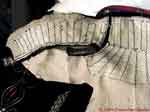 |
 |
| View of padstitched collar area,
focused on center back area, which is one with the "back"
piece. The sides are separately attached. The garment's interlining
is heavy weight unbleached 100% linen. |
View of padstitched collar, with
focus on side collar piece. Part of the embellished front can
be seen in the lower left hand corner. |
Collar interfacing is tailors hair
canvas, which contains goat hair and wool among other fibers.
Padstitching is done completely by hand stitching, to reinforce
and strengthen the collar area. |
 |
|
|
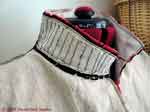 |
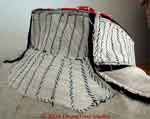 |
 |
| Padstitched collar on dress form;
front view. The front, back and collar pieces have been sewn
together and clipped. The collar has the crimson silk as a visible
lining. The unseen body lining is a medium weight bleached 100%
linen. |
Back view showing more detail. The
visible lines in blue was done in tailors chalk to give me something
to follow while stitching. |
The body and collar are draped over
the back of my office chair. See how the collar stands on its
own without any assistance from a form. |
 |
|
|
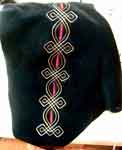 |
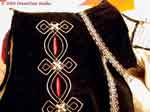 |
 |
| This is a view of the body after
the embellishment has been applied and before the beads area
added, or the garment is sewn to anything else. Crimson 100%
silk shantung is peaking out among the turned back slits, which
is sewn into place. The crimson color is pinker here than actual
because of lighting. |
This is a view of the embellished
upper body area. The cording is 1mm gold and 2mm silver trims
added by machine. The beading are two real stones and freshwater
pearls. Gold braid is attached over seam lines, and down the
front. |
A detail view of the embellishments,
including the beading. I used gold plated beads, freshwater
pearls, garnets, and a black stone (onyx?). The stitches seen
are the guidelines that I sewed from the wrong side. They are
barely visible unless you look very closely at the garment. |
 |
|
|
 |
 |
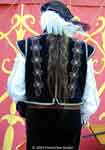 |
| A front view of my husband wearing
the doublet. You can see the crimson lining of the open collar.
I also hand crafted the period thread buttons, that have a garnet
in the center. |
Side view, which shows the blackworked
sleeves of his shirt. The breeches were short lived (velveteen
doesn't survive chaffing) and will be replaced next season. |
Back view showing his lovely long,
soft, curly hair. The hat was borrowed. I've since made him
an Italian bonnet.
|
|














